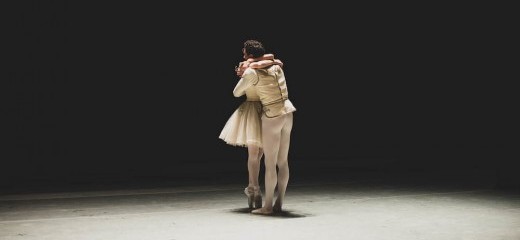
Opulence in Times of Change
by Mira Treatman
George Balanchine’s Jewels, choreographed in 1967 for the New York City Ballet, was the outlier of this season at Pennsylvania Ballet. After the classic story ballets and contemporary works, the triptych posed a challenge for a company with diverse trainings among its dancers. Dancers in Jewels, which is considered the first full-length abstract ballet, must create a mood rather than portray specific characters going through a story arc. While the lack of narrative can be alienating for some audiences, it gives individual dancers crucial opportunities to shine just as themselves, which I find refreshing.
The ballet began with Emeralds, set to Gabriel Fauré’s Pelléas et Mélisande (1898) and Shylock (1889). Verdant and dreamy, Emeralds featured stationary gestural movement, a strong contrast with the space-devouring Rubies and Diamonds, the second and third sections of the ballet. In the first solo, Alexandra Hughes delighted me in the opening; her charisma carried her during moments of lighter technical demands. At one point the music engulfed her in a lush, sylvan hug, but Hughes attacked this through the depths of her back bend: acid cutting through the fat of Fauré’s schlock. Sterling Baca, in Emeralds, was indisputably princely, even though his role does not demand that level of authority. Jermel Johnson approached Emeralds with pure joy as he commanded the petit allegro passages with lucid footwork. These personal approaches to performance reveal much about each individual; I find this more compelling than seeing them interpret a fictional character like Prince Siegfried (Swan Lake). Even without a specific narrative, Emeralds ends with the male principals reaching, in deep lunges, for the women who have just left, continuing Balanchine’s canon of young men yearning for women just out of reach.
The meat of Jewels is the second section, Rubies, set to Igor Stravinsky’s Capriccio for Piano and Orchestra (1929). Rubies was an excellent vehicle for Zecheng Liang. With pyrotechnic leaps and sensitive virtuosity, Liang could successfully take on any athletic endeavor. He had more than just physical aplomb, however, with youthful magnetism and intelligent musicality propelling him across the stage. Also interpreting the male Rubies lead was Ian Hussey, charming and confident as the jock leading the Rubies men. Hussey had real panache in the jazzy material, performing with glamour and little irony. Alongside these leads was stand-out corps de ballet member Peter Weil. A firecracker of a classicist, he demonstrated glee at finishing challenging passages. Throughout the week, Weil performed featured and ensemble roles with equal enthusiasm, a rare trait in a genre that prizes hierarchy.
Rubies fit many of the female dancers like a well-worn glove. Principal Oksana Maslova excelled far more in the Rubies lead than in Diamonds. Graced with superhuman flexibility, her penché exceeded 180 degrees. Where her Diamonds interpretation had gilded pretenses and a cold demeanor, Rubies set her free as a liberated creature. The casting of apprentice Sydney Dolan and principal Dayesi Torriente, who shared the role of Rubies’ tall soloist, was a study in contrast. Dolan’s beaming grin didn’t quite fit the requisite sassy grit this role typically demands, but she stayed on the music with fighting energy. Torriente exuded leggy confidence once she warmed up to the audience, but appeared controlled by the drive of Stravinsky’s maddening score. Regardless of their interpretations, it was still lovely to see bits of vulnerability from these women as they executed the notorious role. Of the Rubies corps women, Adrianna De Svastich exemplified the witty, saucy attitude that I missed in the soloists.
Diamonds, closing the triptych, is set to Peter Ilyitch Tschaikovsky’s Symphony No. 3 in D major, Op. 29 (1875). Known for its long, nine-minute pas de deux, Diamonds is closest to a narrative ballet. The heart of this act however was not the high drama of the duet, but the tensile, spirited material for the demi-soloist women who immediately follow. Holly Fusco shimmered with vibrant maturity in this role. Diamonds was the fête of this run of Jewels with the retirement performance of soloist James Ihde, a dancer with the company for an astounding twenty-five years. In the course of the week, he performed the second pas de deux of Emeralds and the principal in Diamonds, partnering Lillian DiPiazza in both, with humility and attentive presence. There is a poignancy in his tender classicism and the connection he has with his partner. Each time he hit fifth position, Ihde looked like he was home.
Despite the range of trainings, maturity, and confidence in PAB’s dancers, their performances of Balanchine’s choreography revealed camaraderie and teamwork, a welcome sign after several years of turnover. In such a hierarchy, it is touching to see new dancers take on major roles as a senior dancer retires.
Jewels, Pennsylvania Ballet, The Academy of Music, May 10-13
By Mira Treatman
May 17, 2018








